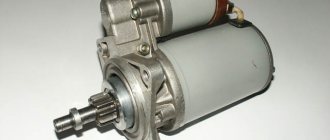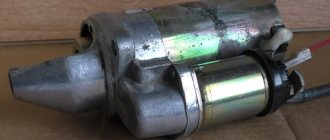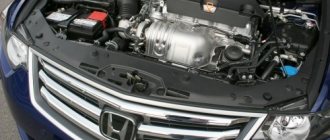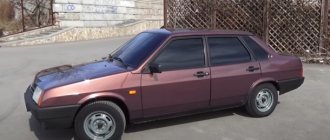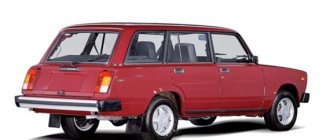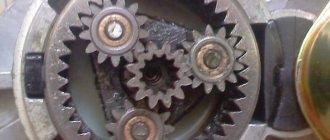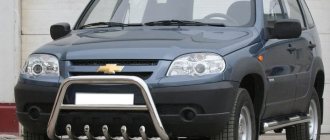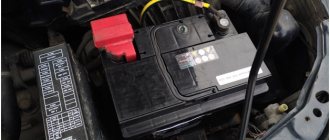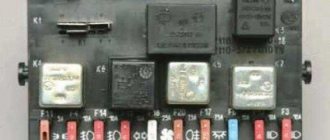I decided to update the BZ, although the entry does not directly concern the 2115, BUT they drove around on my former machine to get all the components)) (so it “helped”). A record about what our people sometimes get to when their head gives no rest to their hands!)) And now the point:
A neighbor has an Oka, which I had the misfortune of driving away in a friendly manner to servicemen I knew to replace the clutch. After this operation, ironically, the clutch cable died for a long time, dragging along with it the new disc + basket + original flywheel. EVERYTHING new was purchased and after that (after installation and short operation) Oka “became capricious” - it gobbled up the new crown. Everything was filmed again, on a rather middle-aged car - 2001. - and replaced - the reason, as always, is small and nasty - the starter bushing (who doesn’t know/forgot - on the Oka with this bushing it’s the same idiocy as on chisels - the bushing is pressed into the clutch housing). They replaced it, installed it - without paying attention to the wear of the seat - a week later it was 25 again - a crunch, a roar and the crown said “let's go for now!”... And since the neighbor was an elderly man and it was not convenient in front of him - it was decided to take on an equally great one (from this is no less a “strange” idea): install a starter from 2110, immediately geared! Well, it seems like there’s nothing further to write about, but we decided to save money))))) The idea is simple - like everything ingenious (my modesty is asleep, because the post is being written at 00:35 this day) - from my grandfather on the Oka an “almost new” KZATE starter was installed, catalog number - 7102.3708-01. So, I persuade him that it’s enough to stop tormenting the bushing - and it turned out that that’s right - because. the seat was divided into an “oval”. The proposal, as some have already guessed, is the following - we take the “head/beak/dome/bell/head” of the KZATE 2110 starter, No. 5702.3708, compare it and try, after finishing it, to screw it on. As a result, in the analysis, for 400 rubles (I know, it’s expensive - nothing, we were showing off) we take the “beak” from this gear starter + (not unimportant) in addition - a gearbox (axle, 3 planetary gears and an old Bendix). As it turned out, this was also not done in vain - why? - further in the text! We look from behind - our option is that the KZATE plant has unification in this part! Looking ahead, I will say that it fits perfectly, except for one thing - the dimensions of the gearbox axles are slightly different - in the 2110th the diameter for the beak bushing is 12 mm, and in Okushny it is 10 mm... That is. The gearbox axis was not superfluous in this situation. It was possible, of course, to have a turner grind a bushing into the “beak” of the 10th starter for the percussion axle - but you need to look for the brauuuuuuun, well, you get it))) In general, we assembled a kind of Frankenstein, we were glad how well done, we checked - everything is spinning, even very well ! It's all about fine-tuning! Everyone remembers that the head of the 10th starter cannot simply be ground to fit the mounting diameter of the eyebox and installed - different heights of the heads will lead to the fact that the bendix will later come off the crown after start-up and wear out. Plus, it’s not a fact that it will come out as expected and, at the same time, supply power to the starter motor. We do what many do here, on D2 - we sharpen 2 washers of 5 mm each for the future “ears” of the starter so as not to break them off. Dimensions of rings - washers - 10*20*5. Why 5 mm - strictly because the height on the 10th starter is 5 mm (don’t ask again - “whaaat?!” - that’s how it should be, 5 mm, everything is okay). And then I got itchy - the starter NEEDS to be centered, a centering RING SHOULD be done, give me a turner and all that))) A turner was found with an acceptable cost of work, material and we began: The starter head, up to the centering stop, is machined to a diameter of 64 mm.
Typical starter malfunctions and ways to eliminate them
Why does the mechanism turn, but cannot start?
Let's consider the main malfunctions in the operation of the device, as well as ways to eliminate them:
- There were problems with the contacts, as well as connections, and the electrical control circuit of the device. It is necessary to diagnose and clean the circuits, and if necessary, clean the contacts.
- Failure of the traction relay. Engine starter for Lada 1111 Oka is on sale. Buy original auto parts, analogues from stores, car dismantling yards, and individuals. In this case, the part must be replaced.
- If the unit turns very slowly, then perhaps the reason lies in the weak tightening of the nuts that secure the wire tips to the relay terminals. This problem can be solved by tightening the nuts.
- It happens that when you try to start the power unit, the traction relay is activated, but then immediately turns off, which is accompanied by a knocking sound. If the ignition switch is working properly, then you need to check the traction relay and, if necessary, replace it. Also, the reason may be the increased resistance of the electrical power circuit of the mechanism; cleaning and fixing the wiring more reliably will solve the problem. If there are damaged sections in the chain, they must be replaced.
- Another reason may be damage to the gear teeth, both in the drive and in the flywheel. If the damage is significant, the parts must be replaced.
If a device fails, it must be repaired, which consists of replacing failed structural components or completely replacing the unit.
Interchangeability of VAZ-1111 and VAZ-11113 starters
September 26, 2012, 12:22 #1
Is it possible to replace the VAZ-11113 starter with a VAZ-1111 starter
September 26, 2012, 12:25 #2
Is there or has there been a forum topic “Interchangeability of VAZ-1111 and VAZ-11113 starters.”
September 27, 2012, 09:29 #3 + 1
September 27, 2012, 11:42 #4 + 1
“As far as I understand, the starters are the same. ". I know for sure that they are structurally different. However, it may happen that:
1. Starter-1111 will not fit (wrongly fit in space) into the place of starter-11113;
2. Torque has different values;
3. The data provided on this website is outdated;
And anyway: Thank you for your friendly attitude.
September 27, 2012, 11:55 #5 + 1
Somehow strangely it is written: “a starter 1111.3708 was installed on some of the cars” without specifying the models: https://www.motor-f1.ru/page464.html
Renault Megane Extreme
September 27, 2012, 18:35 #6 + 2
I changed 2 starters to 11113, without bothering to ask the starter for the Oka, I didn’t even look at the markings, both fit perfectly. If in doubt, take your starter with you and ask for the same one.
September 28, 2012, 21:57 #7 + 1
Serega_karel, September 27, 2012, 11:55, #5
Somehow strangely it is written: “a starter 1111.3708 was installed on some of the cars” without specifying the models: https://www.motor-f1.ru/page464.html
Thankful. looked. I realized that on the VAZ-11113 I have exactly this starter with permanent magnets instead of windings. design: simplified el. circuit, the weight of the starter is reduced. I can explain the rest “after opening” and winter use. I got it. turns poorly (with difficulty). The defect has not yet been identified. but I traveled all over Ukraine with him.
September 28, 2012, 10:05 pm #8
ALEXANDRE, September 27, 2012, 18:35, #6
I changed 2 starters to 11113, without bothering to ask the starter for the Oka, I didn’t even look at the markings, both fit perfectly. If in doubt, take your starter with you and ask for the same one.
I have a couple of Old Design starters. Is it possible to install them on a VAZ-11113. The length of the armature shaft may not fit. Hence my question on the topic. There are similar questions all around.
village Scout Kemerovo region
September 28, 2012, 10:16 pm #9 + 1
KirGen, September 28, 2012, 10:05 pm, #8
I have a couple of Old Design starters. Is it possible to install them on a VAZ-11113. The length of the armature shaft may not fit. Hence my question on the topic. There are similar questions all around.
The starter 39.3708 is a DC electric motor with mixed excitation and an electromagnetic two-winding traction relay. The main difference between this starter and the traditional starters used on most other cars is the absence of support for the end of the armature shaft in the cover on the drive side. The end of the shaft is supported by a bushing pressed into the clutch housing.
A starter 1111.3708 with excitation from permanent magnets was installed on some cars. The book discusses starter 39.3708 as the most common.
Video “We repair the mechanism with our own hands”
Detailed repair instructions are given in the video below (by Sergey Neverov).
In every car, the starter device is one of the main components of the ignition system. Thanks to this mechanism, voltage is supplied, which is subsequently used to ignite the air-fuel mixture. And Oka cars are no exception. Read more about what elements the Oka starter consists of, what its operating principle is, and what malfunctions are typical for it.
Replacement and size of bushings
Those car enthusiasts who have no desire to redo anything to eliminate armature play will have to change the bushings.
Dimensions: thickness 2 mm, inner. diameter - 10mm, outside - 14mm.
There will be no problems with the interior, since it is installed in the back cover and it is not difficult to get it out after removing and disassembling the starter. But the bushing, which is installed in a recess in the block, is difficult to get.
There are several options for extracting it:
- Screw a tap of the appropriate size into it;
- Drill out;
- Squeeze out using grease;
If everything is clear with the first two methods, then the third should be considered in more detail. The method is based on the property of a liquid not to compress.
The extrusion technology is quite interesting - we select a rod whose diameter exactly matches the hole in the sleeve. Next, fill the bushing completely with grease (for example, “Solidol”). Then we insert the rod into the hole and hammer it inside. Due to compression, Solidol will penetrate under the bushing and begin to squeeze it out.
After removing the worn bushing, we install it in its place with a new one, after which all that remains is to put the starter in place.
Characteristics of the starter on Oka
First, let's look at the main functional features of starter devices. Let's start with the design and principle of operation.
Location and purpose
The starter unit is a device used to convert electrical energy into mechanical energy, which is necessary to start the engine. In Oka cars, this mechanism is located under the cooling system thermostat. It is secured with a screw and nut on the clutch housing.
Design and principle of operation of the unit
The mechanism body contains the poles of the excitation winding, which are fixed with special screws. Three of these windings are series connected and one is a shunt winding. The entire structure is secured by two housing covers, secured with screws. On the back cover there is a special brush mechanism with four brushes.
Design
The starter on the Oka is a commutator electric DC motor. Its main components are:
All elements are assembled into a single structure and secured with coupling bolts.
The stator due to the passage of electrical energy through its windings, ensures the emergence of an electromagnetic field. The second magnetic field is created by the armature winding. Electric current is supplied to it through graphite brushes to the commutator, to the plates of which the ends of the armature winding are soldered. The magnetic fields generated around the windings lead to the rotational movement of the armature.
On one side of the armature shaft there are splines on which a bendix is mounted, consisting of a gear and an overrunning clutch. Bendix has the ability to move along the shaft, and due to the spline connection, rotation is transmitted to it.
The Bendix gear is designed to engage with the crankshaft flywheel and transmit rotational motion to it. By default, the gear is not engaged with the flywheel and there is no interaction between the engine and the power electric motor.
The task of the overrunning clutch is to interrupt the transmission of rotation after starting the power unit. Even at minimum speeds, the rotation speed of the crankshaft is higher than the starter speed, so after starting the engine, reverse rotation is transmitted - from the flywheel to the electric motor. engine (until the gear is disengaged), which significantly reduces the service life of the starter. To prevent this negative effect, the gear interacts with the armature shaft not directly, but through a roller clutch, consisting of two cages and rollers placed between them.
Typical starter malfunctions and ways to eliminate them
Why does the mechanism turn, but cannot start?
Let's consider the main malfunctions in the operation of the device, as well as ways to eliminate them:
- There were problems with the contacts, as well as connections, and the electrical control circuit of the device. It is necessary to diagnose and clean the circuits, and if necessary, clean the contacts.
- Failure of the traction relay. In this case, the part must be replaced.
- If the unit turns very slowly, then perhaps the reason lies in the weak tightening of the nuts that secure the wire tips to the relay terminals. This problem can be solved by tightening the nuts.
- It happens that when you try to start the power unit, the traction relay is activated, but then immediately turns off, which is accompanied by a knocking sound. If the ignition switch is working properly, then you need to check the traction relay and, if necessary, replace it. Also, the reason may be the increased resistance of the electrical power circuit of the mechanism; cleaning and fixing the wiring more reliably will solve the problem. If there are damaged sections in the chain, they must be replaced.
- Another reason may be damage to the gear teeth, both in the drive and in the flywheel. If the damage is significant, the parts must be replaced.
If a device fails, it must be repaired, which consists of replacing failed structural components or completely replacing the unit.
How to check the performance of the starter on a VAZ 2110
Of course, you will always have time to disassemble the device, but you should check why the device does not work.
And this check can be done:
- It is necessary to turn the gear in the same direction as the armature of the device turns, and try in the opposite direction, and this should not happen. And if it scrolls in the opposite direction, then this is already a malfunction.
- It is also worth checking the movement of the coupling along the shaft; use a screwdriver for this. If the device is functioning normally, the coupling should turn easily and without snagging.
- To check the serviceability of the starter, you need to connect the wires from the battery. If the device is working properly, then the clutch will have a characteristic click when it extends, and if it does not turn on at all, then you will need to disassemble the starter and find out the reason.
- If the starter stops turning at all, you need to check the armature, that is, remove the cable and connect it to the bolt with contacts. If the armature is working properly, then it will rotate very quickly, but there are cases when the movement is too small, in which case the armature is not working properly.
And now it’s worth talking about how to properly repair a starter on a VAZ 2110 with your own hands. And it’s immediately worth noting that without removing the starter from the car, it is impossible to check its performance and not even carry out repair work.
Starter of the OKA VAZ-1111 - 1113 car
Starter of the OKA VAZ-1111 - 1113 type 39.3708 : 1 - overrunning clutch; 2 - restrictive ring; 3 - drive gear; 4 - drive side cover; 5 — drive lever; 6 — relay anchor; 7 - relay holding winding; 8 - relay pull-in coil; 9 — contact plate; 10 — relay cover; 11 — contact bolts; 12 — casing; 13 - collector; 14 — back cover; 15 — brush; 16 — body; 17- pole; 18 - anchor.
Starter type 39.3708 is a four-brush DC electric motor with mixed excitation and an electromagnetic two-winding traction relay.
Technical characteristics of starter 39.3708:
Rated power, kW 0.9 Current consumption at rated power, A, no more than 230 Current consumption in the inhibited state, A, no more than 310 Current consumption in idle mode, A, no more than 60
Four poles with field windings are secured in the starter housing with screws:
three series (connected in series) and one shunt. The body and covers are secured with two bolts. The anchor is with an end commutator. The rear end of the armature shaft rotates in a metal-ceramic bushing pressed into the cover, and the front end rotates in a bushing pressed into the clutch housing. (When installing the starter, make sure the bushing is in place.) The drive shaft has a freewheel (overrunning clutch) with a drive gear. It transmits torque in only one direction - from the starter to the engine, separating them after the engine starts. This is to protect the starter armature from damage due to excessive speed. The traction relay is used to engage the drive gear with the ring gear of the engine crankshaft flywheel and turn on the power to the starter motor. When the ignition key is turned to the “starter” position, voltage is supplied through an additional relay type 113.3747-10 to both windings of the traction relay (retracting and holding). After closing the contacts of the traction relay, the retractor winding is turned off. The operating voltage of the traction relay should be no more than 9 V at (20±5)°C. If this is not the case, there is a fault in the relay or actuator. The serviceability of the drive is determined by inspection after disassembling the starter. The faulty relay is replaced. On some vehicles, a starter type 1111.3708 with a rated power of 1.0 kW is installed with excitation from permanent magnets (it does not have poles with windings). Six segment magnets are located on the inner surface of the starter housing and are held in place by two plastic holders located near the covers. The covers are secured with two pins, the latter also securing the pole holders.
OKA starter parts with codes:
1111-3708020 Lever 1111-3708043 Cap 1111-3708100 Housing assembly 1111-3708110 Series pole coils 1111-3708160 Parallel pole coils 1111-3708200 Armature 1111-3708300 Cover 1 111-3708340 Brush with tip 1111-3708350 Insulated brush 1111-3708401 Cover 1111 -3708600 Drive 1111-3708800 Starter relay 2101-3708418 Cover plug 2101-3708676 Gear travel limiter 2101-3708678 Retaining ring 2108-3708081 Tie bolt
